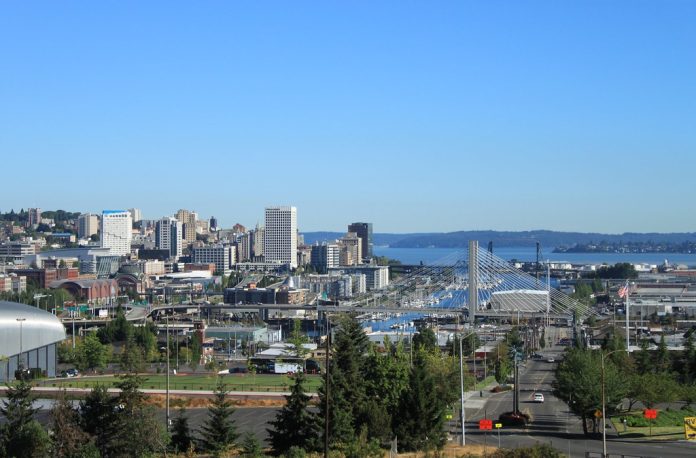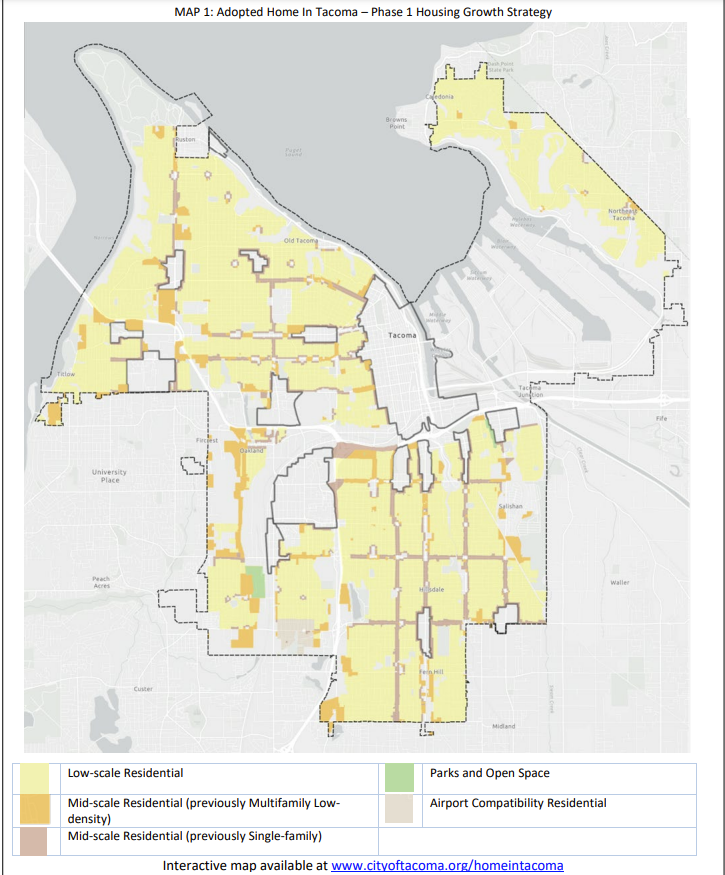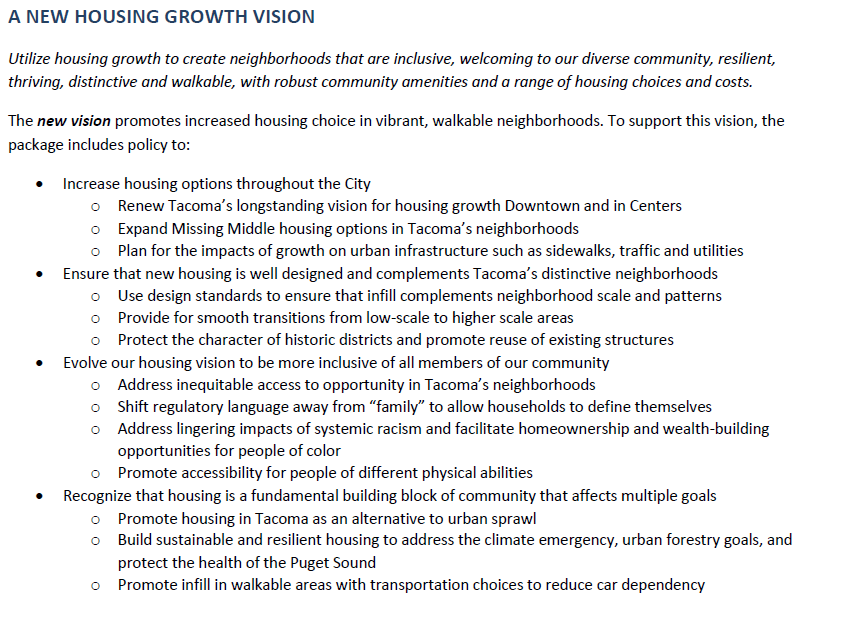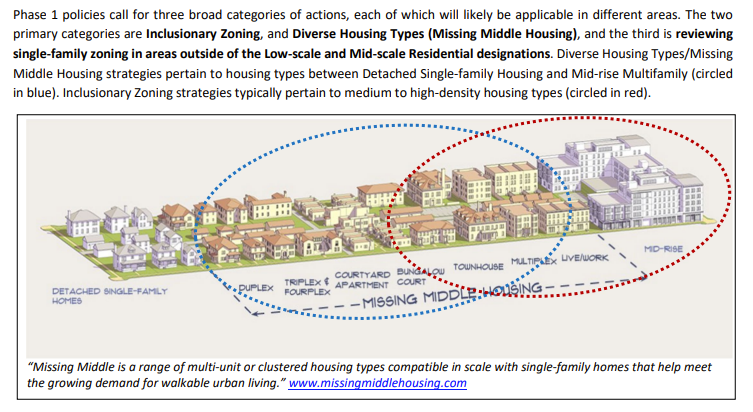
With the official passage of Home in Tacoma in December 2021, the City of Tacoma is finally making moves towards Phase Two: implementation. This phase of the initiative aims to engage the communities of the city more to move off paper and figure out exactly how this plan to increase housing should play out in all of our neighborhoods.
As a reminder, Home in Tacoma is a housing initiative to modify the city’s existing zoning regulations to increase flexibility in future building practices with the goal of creating more housing and further housing affordability. This would be accomplished through rezoning much of the existing single household zoning, which composes about 75% of Tacoma’s residential land. It would also allow homeowners and property developers to modify existing single household homes into multi-unit dwellings (duplexes, triplexes, and the like) or completely replace them with small apartment buildings up to three or four stories tall, depending on the location.
The former zoning category would be called Low-Scale housing, and would lead to the creation of new dwellings approximately the same size as existing single household homes. The latter category would be called Mid-Scale housing, and it would dwellings larger than a single household home, but smaller than the 5-over-1 mid-rise developments we see popping up all over the country.
Low and Mid-scale do not indicate the quality of the housing, but simply its residential capacity. These types of housing would be able to increase Tacoma’s housing stock and combat ever rising house prices and rents. Ultimately, Home in Tacoma is one of many plans in motion that hope to make our city more livable and accessible.
In previous articles, I explored Home in Tacoma through the lens of Geographic Information Science (GIS), a field of study that combines maps and data to solve issues in our physical world. In one analysis, I found a connection between lower equity scores of neighborhoods and the increased presence of Mid-Scale rezoning. Further, I pushed back against calls to “Save Tacoma’s Tree Canopy,” showing that the argument had little weight by examining the true degree of tree canopy across the city.

The implementation phase of Home in Tacoma will work to make sure the voices of communities are heard to make sure the plan is implemented in an equitable, collaborative fashion.
In the Home in Tacoma Scope Report published in mid-March, it’s noted that the City wants to shift away from housing types like single household homes and focus more on building form, design and scale. This would present Tacoma residents with a range of housing options beyond the generic cookie cutter housing quickly built up by non-local developers. Rather, imagine neighborhoods with apartments, homes, and everything in between, with a cohesive aesthetic that is uniquely Tacoma binding it all together.

That is what Home in Tacoma aims to do. To meet these lofty goals, a number of specific housing goals are listed in the Scope Report:
- Zoning capacity to accommodate up to 60,000 new units
- Strive for 35% of urban Pierce County’s residential growth
- Accommodate 80% of the City’s new housing units in and within walking distance of Centers
- Ensure that at least 25% of new housing units are affordable at or below 80% of Pierce County Area Median Income (AMI)
- Numeric targets for households earning less than 30%, less than 50% and less than 80% of AMI
These are ambitious goals and achieving them would allow for Tacoma to grow into a new city. The increased density and walkable neighborhoods would lead to more colorful neighborhoods and stronger communities.
The City has supplemented these housing goals with neighborhood design principles meant to intentionally curate residential spaces:
- Locate missing middle housing in a walkable context with a strong pedestrian orientation implemented through design, access, orientation to the right-of-way, pedestrian-scale lighting, and other features
- Ensure that missing middle housing is consistent with the massing and scale of neighboring structures and uses compatible design language
- Provide for smooth transitions from Low-scale to higher scale areas by preventing abrupt height and scale changes
- Mitigate the appearance of density from the right-of-way and adjacent properties through breaking up the building footprint, appropriate use of setbacks/screening, and limiting height at lot lines
- Build a strong sense of community through integration of shared spaces
- Minimize vehicular orientation through moderate onsite parking, alley access, or shared driveways
There is also additional language that seeks to incentivize the reuse of older viable buildings rather than demolish them. These standards would not only reduce the time and material costs to get middle housing up and running, but also help preserve the visual aesthetics of older neighborhoods.
But the City can’t do this alone. Everyone has a stake in our neighborhoods and communities and the City is willing to listen to make sure this plan is as successful as it can be. The overall scope of Phase Two will include:
- Zoning changes for Low-scale and Mid-scale Residential designations
- Strengthened design standards
- Development of an anti-displacement strategy
- Enhancement and expansion of regulatory affordability tools
- Actions to ensure that infrastructure and services are adequate to support growth
- Actions to address the potential demolition of older structures
- Actions to create green, sustainable and climate-resilient housing
- Actions to promote physical accessibility
- Review of City of Tacoma permitting and processes
- Education and technical support for developers and the public
Personally, I appreciate that the City has anti-displacement strategies and affordability high up on this list. Redevelopment initiatives often focus on the bright and shiny future with unlimited growth potential for the city and its residents. But that isn’t particularly realistic.
We’ve all heard of issues of gentrification pushing people out of their long-time neighborhoods and how wages are not keeping up with rents and mortgages. It’s becoming increasingly difficult to live in Tacoma and the City recognizes that. Putting these priorities early in the list shows their commitment to the long-term feasibility of Home in Tacoma and the communities it will impact. This issue is explicitly called out in the Urban Form chapter of the Scope Report, showing that this is an important issue the City intends to address:
| Policy UF–1.11 Evaluate the impacts of land use decisions on the physical characteristics of neighborhoods and current residents, particularly under- served and under-represented communities. a. Avoid or reduce negative development impacts, especially where those impacts inequitably burden communities of color under- served and under-represented communities, and other vulnerable populations. b. Make needed investments in areas that are deficient in infrastructure and services to reduce disparities and increase equity and where growth and change are anticipated. |
So what’s next? In a newsletter recently sent out, the City outlined next steps:
Tentative 2022 to 2023 Process
- Project Initiation (February to April 2022) [We are here!]
- Information gathering and engagement
- Preliminary alternatives
- Planning Commission public hearing
- City Council review process
On April 20th, 2022, Tacoma’s Planning Commission is hosting a public hearing to hear oral comments regarding the initiative. For those that can’t attend, written comments are due to homeintacoma@cityoftacoma.org by April 30th, 2022.
These comments will be important in helping craft specific language in and around Home in Tacoma. How do we make sure new housing is affordable? How will neighborhood character be preserved or enhanced? How can we make sure everyone has a place to lay their head?
I urge all Tacoma readers to submit comments. We need to make sure that Home in Tacoma can proceed in an equitable fashion that benefits as many residents as possible without discrimination or leaving anyone behind.
To build a Home in Tacoma, we all need to play a role.
For more information, including meeting details, please visit the Home in Tacoma webpage. Comments and questions can be submitted to homeintacoma@cityoftacoma.org.

Kevin Le
Kevin Le is a Geographic Information Science (GIS) professional in Tacoma. He enjoys studying spatial data to better understand our urban landscapes and redesign cities to better serve all people.

